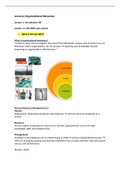Lectures Organizational Behaviour
Lecture 1: Introduction OB
Lecture 1.1 OB, HRM and context
• What is OB and HRM?
What is organizational behaviour?
“A field of study that investigates the impact that individuals, groups, and structure have on
behaviour within organizations, for the purpose of applying such knowledge toward
improving an organization’s effectiveness.”
Human Resource Management (1)
Human:
Employment relationship employer and employee with the focus on employee as a
human
Resource:
Human capital; employees as resources to achieve organizational success through
knowledge, skills and competencies
Management:
Activities to let employees act is a desired way in order to achieve organizational success
refers to managing, guiding and steering employees into a certain direction that will achieve
success and performance
(Boselie, 2002)
, HRM is closed related to OB. HRM concerns the more practical part, so the translation of
how to influence the individual behaviour?
So HRM is the management of organizational work force; so the management of human
resources. And more practical: it is responsible for attraction and selection of employees, but
also for the training of employees and assessing and rewarding of those employees. But
ALSO entails overseeing organizational leadership and culture and also ensuring compliance
with labour loss.
Human Resource Management (2)
The management of work and people towards desired ends (Boxall et al., 2007)
HRM involves management decisions related to policies and practices that together shape
the employment relationship and are aimed at achieving individual, organizational, and
societal goals (Boselie, 2010) on the multiple level of goals HRM will achieve, so the
individual goals of the employee, such as development and satisfaction, but also the
organizational goals, such as financial performance, productivity, efficiency, innovation and
the societal goals, such as sustainability and making life for patients better.
all those organizations have a strong HRM. For example, Buurtzorg: Buurtzorg has a vision
that if you recruit highly educated people, that they are well capable of making decisions of
their own. So you don’t really need managers. You need support staff, but it should be
requested by the team itself.
they distinguished themselves from their competitors based on their HRM. So HRM was
based of their business strategy and that’s what we call: strategic HRM.
Strategic HRM (SHRM)
“Strategic human resource management is defined as the pattern of planned human
resource deployments and activities intended to enable an organization to achieve its goals.
It involves all of the activities that are implemented by an organization to affect the
behaviour of individuals in an effort to implement the strategic needs of a business.”
Evolution of HRM
, HRM has evolved. In the last two decades there was a strong shift from Personnel
management to HRM. So previously we talked about managing people in terms of short
term goals, rules and procedures; more about controlling people and cost containment. And
this was seen as part of the responsibility of the Personnel department. And the shift
towards HRM contains a new view: what’s good for the employees and the employer? HRM
focuses more on the long term, is business oriented and focuses more on commitment
instead of control. There is an important rule for the line managers instead of the Personnel
department or the Personnel leaders.
Major developments in HRM based on a survey about the challenges in HRM, we see here
the focus line lies more on well-being, talent, work-life balance, being flexible, inspiring and
less on control, rules and only being productive.
• Managing talent
• Managing work-life balance
• Managing change and cultural transformation
• Becoming a learning organization
• Improving leadership development
• HRM approaches
Hard HRM versus Soft HRM
there are two sides in approaching HRM:
, 1. Hard HRM: economics, so the trade between input and output, humans are seen as one of
the resources an organization has. > added value, HRM in creating economic value,
increasing financial performance.
2. Soft HRM: more the human side of organizations focuses on fairness, the process, because
they perceive it like we spend a lot of time at work with colleagues. So the relationship with
your colleagues matters. So human is not only a resource, not only a mean to an end, but it
is the most important resource. And a goal on itself. > moral value: employees as human
beings, with feelings and emotions.
Foundational models of (S)HRM
• Michigan model (Fombrun et al., 1984): Narrow
- Hard HRM
- McGregor: Theory X
- Organizational strategy and mission are central it is based on the incentives for
employees to perform, so rewarding employees for performance, paper
performance.
• Harvard model (Beer et al., 1984): Broad
- Soft HRM
- McGregor: Theory Y
- HRM facilitates, employees
are central see people as assets and not costs, so it is more focused on the
development; how to encourage people to perform at their best. It also includes
different aspects of performance, so not only organizational performance and
productivity, but also the well-being of employees as a performance measure. It also
takes the context and the situational factors into account.





